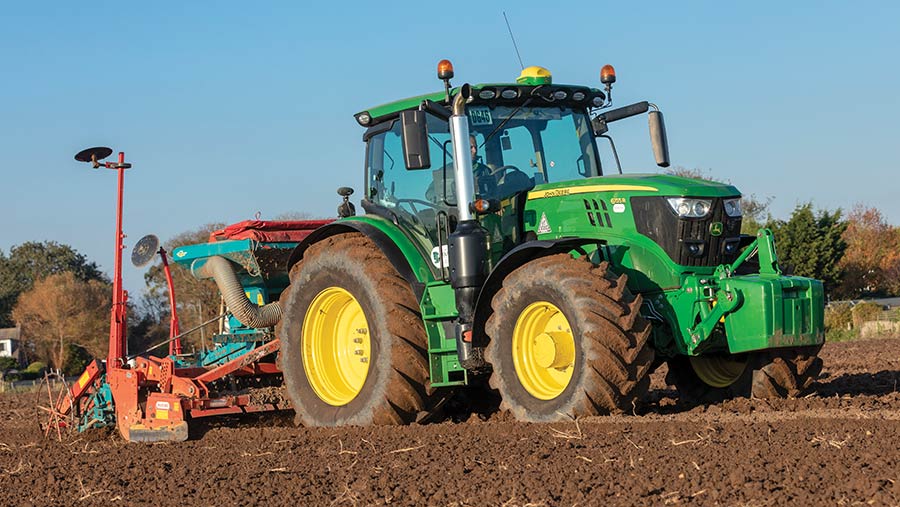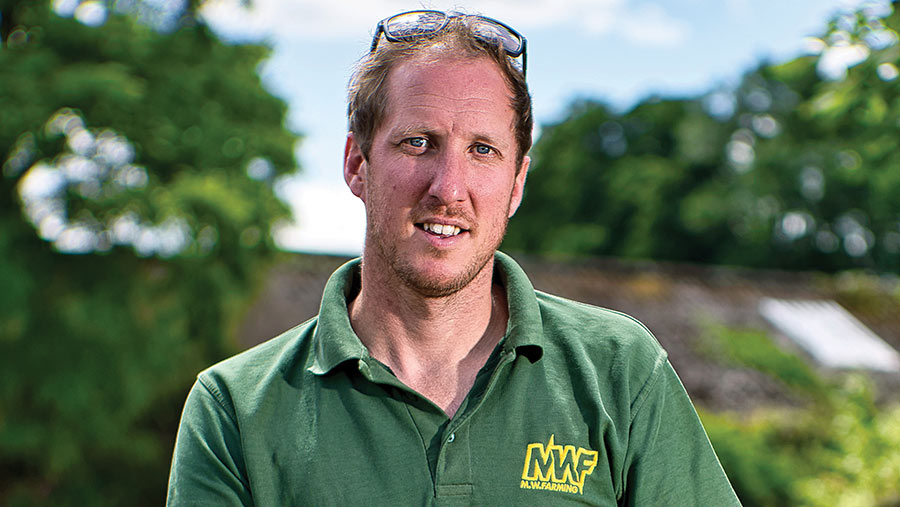What you can do to reduce farm business risk in time of flux
 © GNP
© GNP Pressures on farming businesses have been mounting this year as Basic Payment Scheme reductions continue and both market volatility and interest rates remain high.
So what can be done to improve business resilience and reduce the financial risks? We look at the current advice.
See also: How agriculture policies affect our Arable Insights farmers
After the bumper year of 2022, today’s lower commodity prices have resulted in farms feeling the squeeze and investment plans being revisited.
The government’s shifting stance on its net-zero agenda and the stop-start nature of policy development have added uncertainty.
At the same time, the supply chain’s indifference to elevated costs of production is putting additional strain on farm finances and cash management, as well as the ability to plan for a sustainable future.
Profits need to be made while navigating the changing climate, continuing biodiversity collapse and a cost-of-living crisis, without the safety net of the Basic Payment Scheme (BPS), agree commentators.
“Everyone needs to change,” says Strutt & Parker’s head of farming Jonty Armitage. “That may mean farming in a different way and taking a new approach to risk or working with others, to name just a few options.”
Current support
While Defra’s recent commitment to making accelerated payments to those who enter Sustainable Farming Incentive (SFI) 2023 has been welcomed, the controlled rollout of the scheme means it is unlikely that most applicants will be able to join in time to benefit this year.
An advance payment of 25% in the first month of the agreement – rather than at the end of three months – is the latest government offer.
Given that 10,000 farmers have expressed interest in SFI 2023, the online application process will need to work well.
Defra has also announced three other new support packages, a £4m fund for small abattoirs, a share of £15m for installing rooftop solar equipment and a further £15m for automation and robotics, all aimed to help farming remain competitive.
Bank advice
Amid growing cashflow challenges, the advice to farmers is to remain calm.
While solutions to cashflow issues are unique to individual situations, they typically fall into two scenarios, says Oxbury Bank’s chief risk officer, Robin Hill.
“Usually, it’s either increased working capital facilities to help through a specific situation or proactive management of the current debt to ensure that the actual repayment is in line with the ability to pay.”
That may include payment holidays or an interest-only period, he suggests.
Fixed costs, such as hire purchase, rent, labour and interest charges can be harder to vary – with the latter causing unexpected increases, most of which weren’t budgeted for.
“Speak to your bank if the repayment of the debt is not manageable within existing cash facilities,” Robin advises. “That applies to land rents too – talk to your landlord about deferral or a temporary reduction.”
Ian Webb, Lloyds Bank area director for agriculture in the south and east of England, agrees that communication is key.
“Engage with your bank at the earliest opportunity. While some of the pressures that farms are under have eased a bit, we recognise that there are ongoing challenges with debt profiles.”
A wide range of finance options are available to farms, he reveals.
“It’s usually best to keep the overdraft facility for managing the seasonality of the business and then look at other options for specific projects.”
Finance options
Asset finance is the obvious fit for new machinery and equipment, which has a shorter term repayment window, while longer term loans – for up to 25 years – should be used for business growth, he suggests.
This may include land purchase or a renewables project, such as solar or wind, or a development that helps to secure the farm’s capability and add in resilience, as well as meet the green agenda.
“A reservoir is a good example. Winter water storage means the business is less reliant on rainfall during the growing season, says Ian.
It is also used for diversification projects – most of which are in tourism, renewables or property, he reveals. These may involve bringing in other professionals, such as accountants and solicitors, especially where lease arrangements are made.
“Despite the current climate, there are plenty of farmers wanting to take their businesses forward and who have identified what they need to do,” says Ian.
He adds that it’s important that the length of the loan fits the investment requirement, which is why banks need to understand what the cashflow will look like and will require a detailed financial forecast with some sensitivity included.
“That helps us to agree on the timescales – should the loan be for 10 years or for longer, for example?
“If you have a vision for the medium term, then you need to look at the best way of funding that. Banks can help if they are given the right information and are involved at an early stage.”
Managing the constant state of flux – some pointers
- Minimise overhead costs
- Set goals and budgets
- Benchmark your performance
- Understand the market
- Focus on detail
- Develop your people management skills
- Specialise
Managing risk
For Jonty, the loss of BPS means that many farms will inevitably have to take on more risk, so that they can reduce their costs.
“With machinery, for example, that may mean having fewer, smaller options at your disposal,” he says. “While that leaves you exposed in the year that brings exceptional weather or unusual circumstances, those don’t happen very often.”
Most farms are over-resourced when it comes to machinery, he adds.
“Making better use of kit, especially the bigger and more expensive machines, is an obvious move. With their higher work rates, they can lend themselves to a number of sharing opportunities.”
These can be simple agreements, with costs being split between the parties on a per hectare basis, or they may evolve over time and become contract farming agreements (CFAs).
“The choice between the two comes down to attitude to risk,” he continues. “One is about machinery sharing and the other is about spreading costs – but they both result in machinery being used over a bigger area. In a CFA, only one party carries the risk of machinery ownership.”
While CFAs remain popular, there are situations where some are being converted into Farm Business Tenancies, says Jonty.
“As the risk in farming increases, some landowners prefer to take a fixed rental payment than a share of the profits. Profitability has always been uncertain in farming, even with the safety net of the BPS.”
Case study: Transition farmer Matthew Williams

Matthew Williams © Richard Stanton
For first-generation arable farmer Matthew Williams, who works with nine different landowners in Shropshire, expenditure is the one thing he can control in the current climate.
Despite farming 1,100ha, he will receive just £6,000 in BPS this year, so isn’t too concerned about how the business will make up any funding gap in future years and points out that it won’t go bust without this support.
Instead, he is committed to making good margins for both parties, so keeps a tight rein on costs and runs a low-disturbance, sustainable farming system – in line with expectations and policy developments.
“The business side is what makes me tick,” he admits. “I’ve got no control over world markets, but I can influence whether we make money or not this year and how we grow our crops.”
Having started his business in 2016 with next to nothing, it doesn’t carry any unnecessary costs or equipment and over time he has reduced his reliance on contractors – which were an essential resource in the early days.
“Crunching the numbers showed that it made sense for me to buy my own baler, which I did in 2019,” he says. “Until that time, I used contractors.”
A switch to liquid fertilisers has saved £18/ha on nitrogen, improved accuracy and helped to stretch out cashflow, as the last tanks to be filled on the farm in the growing season don’t have to be paid for until May or June.
Even in 2022, when fertiliser prices hit levels that had never been seen before, Matthew managed to have an average nitrogen cost of £635/t.
“I left the phosphorus and potassium purchases to the last minute as they were coming down in price – as a result, we benefited from a massive reduction.”
He employs two distributor agronomists to help with decision-making and puts the farm data through the Yagro platform, which gives him his costs of production and shows how the business is performing compared with others.
Although he describes himself as frugal, Matthew stresses that he is willing to spend if there is a return on offer.
A good example was his use of a foliar micronutrient product on wheat last year – for a cost of £6.50/ha he saw a 0.8t/ha yield increase.
“We saw some of our best wheat yields from it so I have committed to apply the product to all of our wheat this year.”
He is reluctant to pay a premium for new genetics, so sticks to wheat varieties that have performed well on the farm in previous years and have the characteristics that make them easy to manage.
Farm-saved seed is used in some circumstances.
“We’ve got a couple of blocks of triticale being grown on our lighter ground – it has the necessary drought tolerance and requires fewer inputs.”
He sees the biggest risk for agriculture in England is land going into environmental schemes and being taken out of production.
As he doesn’t own any land, Matthew’s diversification options are limited. He does, however, run a couple of lorries, which provides another revenue stream and complements the farming activities.
Any business expansion opportunities are assessed very carefully.
“When I started, I needed more land to spread my fixed costs. Now I’m lucky enough to be in a position which allows me to stand back if the deal isn’t right.
In the meantime, he is focused on the little wins, such as the SFI 2023 and premiums for growing sustainable crops.
“I get huge satisfaction from farming sustainably while both the farmer and the contractor make a good return.”
Control of inputs
When it comes to reducing input costs, he reports that there has been a move away from liberal applications of fertiliser – largely due to huge price hikes.
Other sources of nitrogen and targeted applications have been adopted, with rates being scrutinised.
“It’s important farmers don’t walk away from this better practice, even though fertiliser prices are back to more-normal levels.”
Those already in soil carbon schemes or supply chain partnerships, most of which are found in dairy and fresh produce, will be committed to this new approach.
Others need to recognise that the green agenda will impact them too and find ways to engage with it sooner, rather than later, he remarks.
“Reducing your focus on yield is possible if you are being rewarded in other ways for sustainable practices.”
Otherwise, higher interest rates are forcing changes to the management of cashflows and putting the emphasis on better payment terms, with businesses able to negotiate delayed terms and saving money.
“Money in the bank at the moment is worth more,” he explains.
“So the longer you can keep it there, the better.” That also applies to any sales strategy.
“If you are going to sell later, you need to know that there will be an uplift in the price. It costs you to keep grain in the shed.”
What about diversification?

© outboundexplorer/Adobe Stock
There hasn’t been a huge uplift in diversification projects in the past few years although the Farm Business Survey results show a steady increase in the amount of income coming from diversification.
“Most of this activity has been around the development and letting of buildings,” says Jonty Armitage.
“There’s good demand for housing and commercial lets, with rents being seen as a safe, guaranteed income.”
Diversified businesses don’t happen overnight and they shouldn’t be seen as a replacement for BPS, he stresses.
“Some of them fail, others prosper over time and become the dominant business.”
Ring-fencing
Getting investment for a new venture may need a fresh approach, he says, as ring-fencing the new business can make it more investable.
“You also have more lending opportunities to choose from – a partnership can work well.”
Natural capital markets haven’t been big income streams to date and it’s becoming clearer with every day that they will be part of the mix on farms, rather than the salvation, he summarises.
“For most farms, food production will remain the core business.”
Contract farming returns
Latest comparison figures from Ceres Rural show that contract farming agreements (CFAs) remain popular, despite reducing returns and profits since the record year of 2022.
The company’s data comes from 54 CFAs, covering 13,900ha of arable land, with the most recent 2023 figures being an estimate based on the results from 41 farms, reports consultant Seb Young.
An increase in the contractor charge in 2022 to £277/ha – the highest since the comparison started in 2018 – reflects the greater level of risk being experienced by the farming industry in that year and the need for contractors to ensure that all costs were covered.
“Although 2022 was the best farming year that many can remember, there were plenty of unknowns when it came to cashflow requirements and whether the markets would cover the costs of growing and harvesting crops,” says Seb.
The contractor charge is expected to be higher again in 2023, at an average of £294/ha, as the combination of rising costs, reducing BPS and market uncertainty continue to create difficulties for farming businesses.
“Many businesses were carrying two years of fertiliser costs in 2023,” he continues. “They then had a much more mediocre harvest, so the figures that we have to date for 2023 reflect that.”
In the same way, the farmer total returns for harvest 2022 were much higher than previous years, also being the highest seen within the Ceres Rural dataset.
At £589/ha, it was £119/ha higher than 2021.This has dropped to an estimated £412/ha for harvest 2023.
The greatest increase seen in all the Ceres Rural figures is the contractor total return for harvest 2022.
At £601/ha, this figure is £120/ha higher than the previous year. Again, we see this coming down substantially for harvest 2023.”
Ceres Rural partner Ed Hutley points out that unless commodity prices rise, figures for 2024 will be very similar to those of 2023. “It all looks quite flat,” he comments.
Contract farming returns – 2018-23 (forecast) |
|||||||
| Harvest year | No of data sets | Average farm size (ha) | Contractor charge* | Farmer total return** | % Total return of farmer | Contractor total return** | % Total return of contractor |
| 2018 | 29 | 232 | 267 | 305 | 45% | 380 | 55% |
| 2019 | 31 | 251 | 273 | 345 | 46% | 412 | 54% |
| 2020 | 45 | 262 | 265 | 324 | 46% | 375 | 54% |
| 2021 | 46 | 270 | 274 | 470 | 49% | 481 | 51% |
| 2022 | 54 | 254 | 277 | 589 | 49% | 601 | 51% |
| 2023 forecast | 41 | 234 | 294 | 412 | 48% | 441 | 52% |
| *(£/ha) **(Inc D/S) (£/ha). NB The 2022 Basic Payment Scheme £/ha has been added to the farmer total return for five farms where the income is not included within the CFA. | |||||||